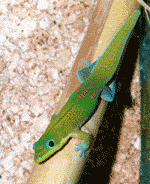Day geckos (genus Phelsuma) - Beauties from Madagascar
 Most members of the family Geckonidae are nocturnal animals. But there are some exceptions too. Among these are the members of the genus Phelsuma, the so called Day geckos. They inhabit the island of Madagascar, which lies off South-East Africa. But Day geckos are also distributed on some "nearby" islands like the Comores, the Seychelles, Nossi B�, Aldabra, Assumption and Sainte Marie. Some species also can be found in some coastal regions of South-East Africa.
Most members of the family Geckonidae are nocturnal animals. But there are some exceptions too. Among these are the members of the genus Phelsuma, the so called Day geckos. They inhabit the island of Madagascar, which lies off South-East Africa. But Day geckos are also distributed on some "nearby" islands like the Comores, the Seychelles, Nossi B�, Aldabra, Assumption and Sainte Marie. Some species also can be found in some coastal regions of South-East Africa.
Like other Geckos Day geckos are known for their capability to walk on smooth vertical surfaces. They are even able to stick on ceilings. This capability requires a certain construction of the Gecko foot. The toes have scales on their undersurfaces, which are widened out as cushions. A lot of bristles are located on these cushions, giving them an appearance like pin-cushions. But also the bristles branch into smaller elements, which can be examined only by microscope. How the adhesion works exactly is disputed. Perhaps it's a combination of several factors. First there is the possibility of a suction effect, but the bristles might also work like small hooks sticking to the surface. But there is a significant disadvantage concerning that way to move: In order not to damage the structure of the cushions, Geckos have to remove each single toe seperately from the surface, which is time-consuming and gives a certain waddling appearance to their walk. Thus the possibility of getting caught by a predator is relatively high. In order to escape the predator, Geckos use a trick, which can be found in many other lizard species too: The Gecko tail easily breaks off. So the predator has to content itself with the tail, while the Gecko manages to escape.
The Gecko's body is more flat than in other lizards and covered with a smooth skin and small scales. Also their eyes are different from those of most other lizards. Nocturnal living Geckos have eyes like vertical slits, whereas Day geckos have round eyes. Like in most other Gecko species the eyelids of Day geckos are immovable and grown into one. They form a transparent capsule protecting the eye. In order to clean their eyes and to regain clear sight, Geckos lick their eyes with their long tongue. The Geckos' optical sense is well developped. While hunting insects and their larvas they primarily use their eyes.
The Day geckos of Madagascar inhabit trees. Some species often can be found on plantations in close neighbourhood to human settlements. Day geckos are solitary living animals but sometimes also can be seen in pairs. Males are very aggressive towards each other. The number of eggs is very small, mostly there are just two. But females lay quite frequently. Eggs and newly hatched Day geckos are very large.
Due to their colourful, mostly greenish skin, Madagascar's Day geckos are among the most beautiful lizards. This made them very popular terrarium animals. Many Day gecko species are relatively easy to keep in a terrarium that should be higher than long, heated and quite moist according to Madagascar's climate. Especially the so called Madagascar day gecko (Phelsuma madagascariensis) can often be seen in captivity and is bred regularly. But before buying a Day gecko one should inform oneself about the needs of such an animal. In addition it's necessary to obtain a cites-certification.
This article was originally published at magazine.naturspot.de. Link to the original article
Phelsuma laticauda laticauda Photograph by Jurriaan Schulman
two comments:
Thanks for the “Animal of the Day”.
I have put it on my site. And I love it and I know that my visitors and guests will love it too.
Orikinla Osinachi (Email) (URL) - 17 09 05 - 17:10
I think the oncilla is soooo cute and fuzzy!
![]()
Beki (Email) - 30 03 08 - 17:50
